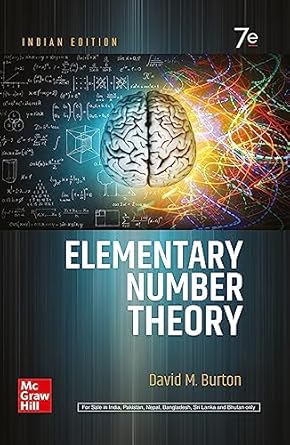
Original Title
Elementary Number Theory
Subject & College
Publish Date
1991-01-01
Published Year
1991
Publisher, Place
Format
paperback
Language
English
Average Ratings
Readers Feedback
Elementary Number Theory
"Book Review of “Elementary Number Theory” Submitted By: Yasmeen Asgarkhan Pathan, MSc Mathematics, Part - II, Roll No:13 M.S.G. College, Malegaon Camp, Malegaon Title of...Read More
Pathan Yasmeen Asgarkhab
Elementary Number Theory
“Book Review of “Elementary Number Theory”
Submitted By: Yasmeen Asgarkhan Pathan, MSc Mathematics, Part – II, Roll No:13
M.S.G. College, Malegaon Camp, Malegaon
Title of the book: Elementary Number Theory
Author: David M. Burton
Edition: 2nd edition
Book Review:
Number theory is the branch of mathematics concerned with properties of the positive integers (1, 2, 3, …). Sometimes called “higher arithmetic,” it is among the oldest and most natural of mathematical pursuits. Elementary number theory refers to those problems whose solution does not require methods from calculus. It is not complex in nature. The buzzwords Riemann Hypothesis, Twin Prime Conjecture, and Fermat’s Last Theorem were supposed to be the core part of the number theory. The great computer scientist Donald Knuth once said, “Virtually every theorem in elementary number theory arises in a natural, motivated way in connection with the problem of making computers do high-speed numerical calculations.”
This book offers a complete and systematic treatment of elementary number theory. “Elementary” in the title refers to the fact that the book only uses proof techniques that are taught to high school students. Apart from comfort with mathematical writing, the only mathematical background needed for this book is high school algebra, and basic proof techniques like induction and proof by contradiction. Burton’s work is therefore a treatise on everything that can be understood clearly and distinctly in the realm of number theory using a basic toolkit. Moreover, the fact that the book organizes the topics so well and gives a thorough treatment of each topic makes the work a great reference book. An anonymous mentioned that the best way to learn something is not to read a textbook but rather to organize the information in a way that your brain is ready to accept. The linear flow of a textbook is supposedly unwelcome to our brains.
The admirable quality of this book is its coverage of the history of number theory. Every chapter in the book begins with a few pages of prose describing the mathematician whose work is going to be featured in that chapter. It explores interesting things about Euclid, Pythagoras, Fermat, Euler etc. This book gives the reference of textbooks from which these great men learned their number theory from and how that influenced their writing and work. It also includes the humanity in the form of Euclid’s Elements and Diophantus’ Arithmetica. Many of the exercises in the book are problems that great mathematicians created and wrote down in their treatises or letters to each other
The book’s confidence in the face of any problem, no matter how big or how small, was inspiring to researcher. After setting up fairly basic notions like division and the greatest common divisor. Chapter of Goldbach’s Conjecture states that every even integer greater than two can be written as the sum of two prime numbers. This is exactly the kind of long-standing open mathematical problem that shied researcher away from number theory in the past. Elementary techniques can, for example, clarify what key theorems or lemmas need to be tackled with more advanced techniques. They can also point out how slight modifications to the question make the question break open in a very easy way. For example, although it is hard to prove Fermat’s Last Theorem in general, to prove it for the case of the fourth power is just one page in this book. A short argument in the book also establishes that Fermat’s Last Theorem need only be proved for prime powers for the whole result to follow.
”
